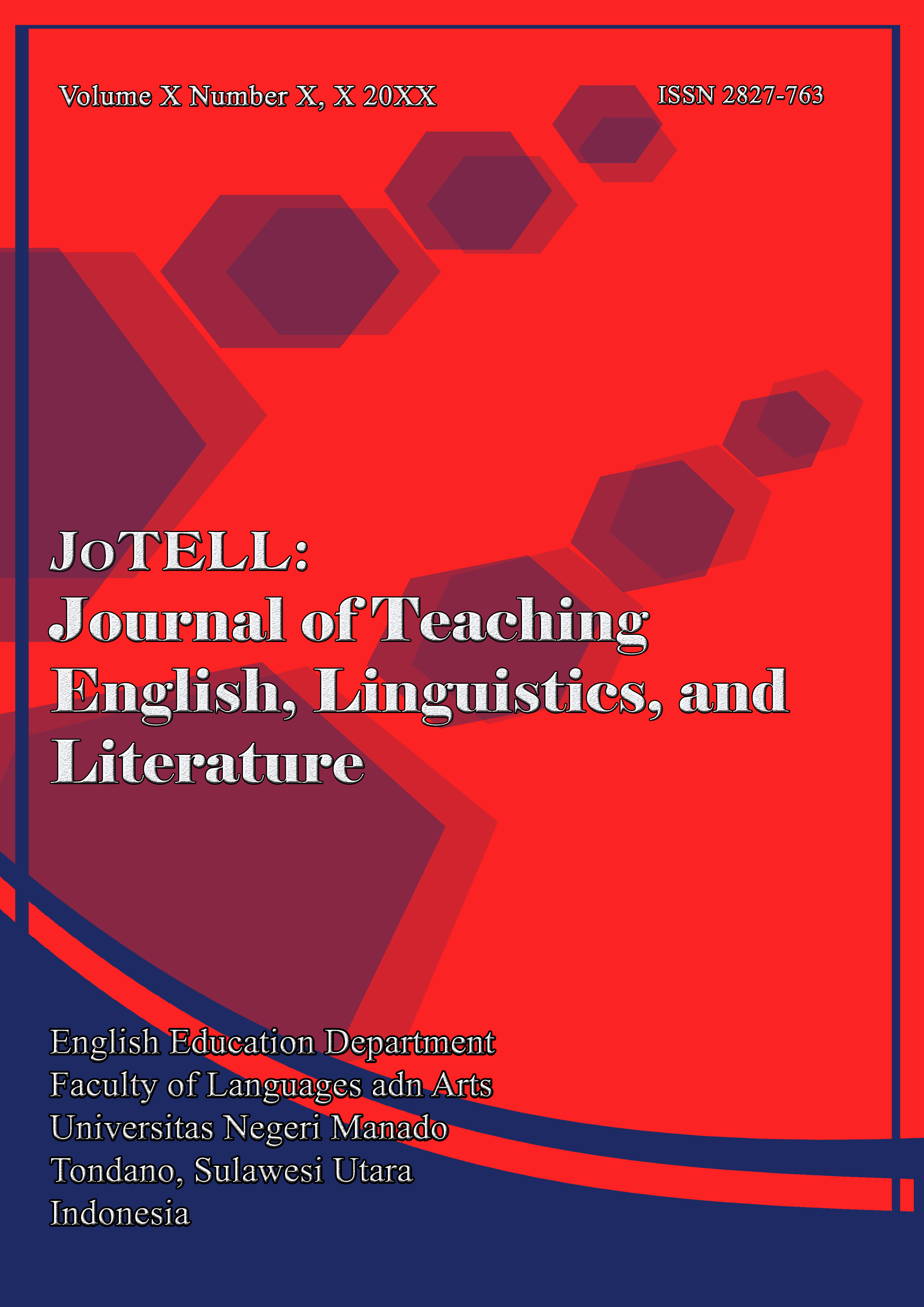THE USE OF SHORT STORIES AS MEDIA TO DEVELOP STUDENTS READING COMPREHENSION AT ELEVENT GRADE STUDENTS AT SMK KRISTEN 2 TOMOHON
DOI:
https://doi.org/10.36582/jotell.v2i9.7393Keywords:
Short Stories, As Media, Develop, Reading ComprehensionAbstract
This research focus on the use of short stories as media to develop students' reading comprehension at elevent grade students at SMK Kristen 2 Tomohon. The research sample consisted of 20 students at class Fase F XI TJKT 1. A quantitative research method was used, employing a Pre-Experimental Design form of one group pre-test and post-test design. The instrument used in this research was a multiple-choice test consisting of 20 items. Data were analyzed using mean score formula to see significant differences between the pre-test and post-test scores. The results showed that there was a significant difference between pretest and posttest scores. The result of students’ pre-test was 44,1 and the post-test was 76,25. The different score between pre-test and post-test was 32,15. The result of this research is indicate that mean score of post-test was higher 32,15% more than pre-test. This shows that the use of short stories method is effective to develop students' reading comprehension at elevent grade students at SMK Kristen 2 Tomohon. In addition, students report that the short stories helps them to focus more and understand the text better. In conclusion, this research recommends that the short stories method be used as an alternative learning in teaching reading especially reading comprehension in schools.
References
Ashadi Kurniawan, Improving Students’ Reading Comprehension on Narrative Text Through Story Mapping Strategy (skripsi, teacher training and education faculty, Tanjungpura University, Pontianak, 2013), p.4.
Diyanni, Robert Literature : Reading fiction, Poetry and Drama 5th Ed, (New York: McGraw-Hill, 2002)
Harmer Jeremy, The Practice of English Language Teaching: 3rd Edication Completely Revised and Update. (Malaysia: Longman 2002)
Kalangi, M., Liando, N., & Maru, M. (2019, November). The effect of applying internet browsing in improving students’ reading comprehension skill. In International Conference on Social Science 2019 (ICSS 2019) (pp. 861-865). Atlantis Press.
Kristin Lems, et.al.,Teaching Reading to English Languager Learners: Insight from Linguistics, (New York: The Guildford Press, 2010), p.170. 11Ashadi Kurniawan, Op.Cit.
Lazar, Gillian, Literature and Language Teaching: A guide for teachers and trainers, (Cambridge: Cambridge University Press, 1993)
Liando, N. V. F., & Martha, S. (2021). Digital Media and Students’ Writing Ability. Journal of Educational Method and Technology, 2(3).
Liando, N. V., Dallyono, R., Tatipang, D. P., & Lengkoan, F. Among English, Indonesian and local language: Translanguaging practices in an Indonesian EFL classroom. Indonesian Journal of Applied Linguistics, 13(1).
MacMillan Literature Series, Introducing literature, Signature Edition, (New York: Glencoe/McGrowhill 1985)
Mubarak, P, Mustafa, and Emhemmad M, A., Zamzan, Investigating the Role of Short Stories in Overcoming the problem paced by the Libyan EFL Leaners in Reading Comprehension Skil, The Criterion An International Journal in English, Vol 12, 2013
Munadi, Y. (2011). Media Pembelajaran Sebuah Pendekatan Baru. Ciputat: Gaung Persada Press.
Nuttal, C. (1992). Teaching Reading Skills in Foreign Language. London. Heinenmann Educational Books.
O’ Hara, Shelley, Improving your Study Skill, Portable edition, (United State: Wiley Publishing, 1998)
R. Day, Richard, and Baford, Julian, Extensive Reading in the second language Classroom, (New York: Cabridge Universitas Pess, 1998)
Rondonuwu, O., Liando, N., & Olii, S. (2022). Students’perception In English Teaching And Learning Concerning Native-Speakerism. JoTELL: Journal of Teaching English, Linguistics, and Literature, 1(2), 175-195.
Rust Hill, Wriring in general and the short story in particular, (Baston : Library Of cougreas in publication, 1977)
S, Pardo, Laura, What Every Teacher Needs to Know about Comprehension. (International Reading association 2004)
Scarlet R., Tini M., Imelda L. (2022). African-American Women’s Power in Margot Lee
Shetterly Hidden Figures. Jo TELL: Journal of Teaching English, Lingustik, and Literature. Vol.1, Issue 12, pp.1416-1428.
Tarihoran, Nafan, Reading Basic Reading Skills 1, (Loquen Press: Serang)
Techique to the First Year Students Of SMA Negeri 1 Ratahan. Journal of Educational Method and Technology. Vol.2.No.3pp41-54
The Disadvantage of Using Short Story in Learning. https://text-id.123dok.com/document/wq2n1o66q-the-disadvantage-of-using-short-story-in-learning.html
Tini M. (2019). Enhancing Students’ Speaking Ability Through Small Group Discussion
Tini M. (2022). Students’ Critical Thinking Ability in English Teaching and Learning Journal of Education and English Literature (JUPENS)2 (3).
Tini Mogea. (2018). Frienship in White’s Charlotte Web. E-Journal UNIMA . Vol. 5, Issue 1. Tini M. 2020. Organizational Behavior: Structure an Culture. K-Media Publisher.
William Grabe and Fredricka L. Stoller, Reading for Academic Purposes: Guidelines for the ESL/EFL Teacher, Teaching English as A Second or Foreign Language, 3rd Ed. Marianne Celce-Murcia (Boston: Heinle & Heinle, 2001), p.188.
Wood, David, How Children think and learn. (Oxford, UK: Blackwell LDT: 1998)
Downloads
Published
How to Cite
Issue
Section
License
Copyright (c) 2023 JoTELL : Journal of Teaching English, Linguistics, and Literature

This work is licensed under a Creative Commons Attribution-ShareAlike 4.0 International License.












